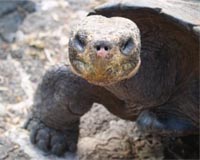| . |  |
. |
Chicago IL (SPX) Dec 07, 2009 The largest known mass extinction in Earth's history, about 252 million years ago at the end of the Permian Period, may have been caused by global warming. A new fossil species suggests that some land animals may have survived the end-Permian extinction by living in cooler climates in Antarctica. Jorg Frobisch and Kenneth D. Angielczyk of The Field Museum together with Christian A. Sidor from the University of Washington have identified a distant relative of mammals, Kombuisia antarctica, that apparently survived the mass extinction by living in Antarctica. The new species belongs to a larger group of extinct mammal relatives, called anomodonts, which were widespread and represented the dominant plant eaters of their time. "Members of the group burrowed in the ground, walked the surface and lived in trees," said Frobisch, the lead author of the study. "However, Kombuisia antarctica, about the size of a small house cat, was considerably different from today's mammals - it likely laid eggs, didn't nurse its young and didn't have fur, and it is uncertain whether it was warm blooded," said Angielczyk, Assistant Curator of Paleomammology at The Field Museum. Kombuisia antarctica was not a direct ancestor of living mammals, but it was among the few lineages of animals that survived at a time when a majority of life forms perished. Scientists are still debating what caused the end-Permian extinction, but it was likely associated with massive volcanic activity in Siberia that could have triggered global warming. When it served as refuge, Antarctica was located some distance north of its present location, was warmer and wasn't covered with permanent glaciers, said the researchers. The refuge of Kombuisia in Antarctica probably wasn't the result of a seasonal migration but rather a longer-term change that saw the animal's habitat shift southward. Fossil evidence suggests that small and medium sized animals were more successful at surviving the mass extinction than larger animals. They may have engaged in "sleep-or-hide" behaviors like hibernation, torpor and burrowing to survive in a difficult environment. Earlier work by Frobisch predicted that animals like Kombuisia antarctica should have existed at this time, based on fossils found in South Africa later in the Triassic Period that were relatives of the animals that lived in Antarctica. "The new discovery fills a gap in the fossil record and contributes to a better understanding of vertebrate survival during the end-Permian mass extinction from a geographic as well as an ecological point of view," Frobisch said. The team found the fossils of the new species among specimens collected more than three decades ago from Antarctica that are part of a collection at the American Museum of Natural History. "At the time those fossils were collected, paleontologists working in Antarctica focused on seeking evidence for the existence of a supercontinent, Pangaea, that later split apart to become separate land masses," said Angielczyk. The fossils collected in Antarctica provided some of the first evidence of Pangaea's existence, and further analysis of the fossils can refine our understanding of events that unfolded 250 million years ago. "Finding fossils in the current harsh conditions of Antarctica is difficult, but worthwhile," said Angielczyk. "The recent establishment of the Robert A. Pritzker Center for Meteoritics and Polar Studies at The Field Museum recognizes the growing importance of the region," he said. Share This Article With Planet Earth
Related Links Field Museum Darwin Today At TerraDaily.com
 Giant tortoise in France dies at 146
Giant tortoise in France dies at 146Paris (AFP) Dec 4, 2009 One of the oldest giant tortoises in Europe has died at its home in Paris at the age of 146, its carers said on Friday. Kiki, a male tortoise, was brought to France fully grown from Mauritius in 1923, Michel Saint-Jalme, director of the wildlife centre in Paris's Jardin des Plantes where the animal lived, told AFP. Kiki stayed in Paris throughout the German occupation in the World War ... read more |
|
| The content herein, unless otherwise known to be public domain, are Copyright 1995-2009 - SpaceDaily. AFP and UPI Wire Stories are copyright Agence France-Presse and United Press International. ESA Portal Reports are copyright European Space Agency. All NASA sourced material is public domain. Additional copyrights may apply in whole or part to other bona fide parties. Advertising does not imply endorsement,agreement or approval of any opinions, statements or information provided by SpaceDaily on any Web page published or hosted by SpaceDaily. Privacy Statement |